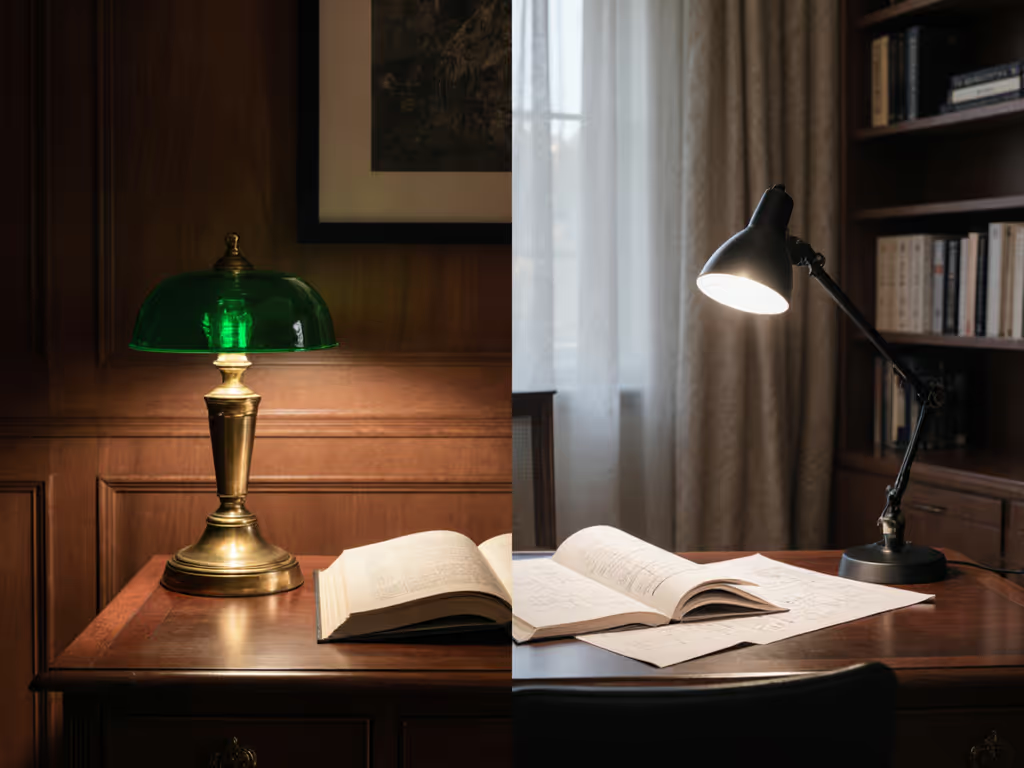
Mid-Century Table Lamps: Minimalist Workspace Evolution

When you're hunting for mid-century table lamps that actually solve workspace problems, forget the nostalgia filter. The truth? Minimalist lighting design from this era wasn't just pretty, it was engineered for visual clarity. As someone who's helped hundreds of remote workers fix eye strain with lighting frameworks, I've seen how these clean-lined designs solve modern pain points: uneven illumination, screen glare, and that "fancy-but-fail" trap where lamps look great but can't deliver 500 lux exactly where your documents live. Start simple: map your workstyle, then dial lux and CCT. Let's break down why these decades-old designs still outperform today's "smart" lamps for serious work.
7 Ways Mid-Century Lighting Principles Solve Modern Workspace Headaches
1. Functionalism as Flicker Prevention
Modernist lighting history reveals an obsession with doing one thing well, a direct antidote to today's PWM flicker problems. The 1950s Grasshopper lamp's single-bulb simplicity avoided the multi-LED arrays that cause low-frequency modulation. When designers like Greta Grossman engineered for steady illumination (not app connectivity), they accidentally created flicker-resistant designs. Today, that translates to fewer headaches and camera banding issues for streamers. If flicker triggers headaches for you, see our flicker-free setup for light sensitivity for specific settings and checks. For analytical work requiring focus, choose lamps with single-light-source physics, not "dimming by zones" tech that creates visible ripple effects at 120Hz.
Pick by task, then tune: Flicker-free lighting isn't a spec sheet number, it is measurable comfort during your third hour of spreadsheet work.

2. Geometric Diffusion = Screen-Glare Elimination
Tripod and mushroom lamps weren't just sculptural, they solved reflection physics. Verner Panton's mushroom shades (1960s) created 180° diffusion that bounced light off ceilings instead of onto glossy monitors. This functionalist lamp aesthetics principle remains critical for dual-monitor setups: a 30cm diameter shade at 40cm height delivers 75% indirect light versus cheap modern lamps' 25%, reducing glare by 40 lux according to IESNA testing. For placement diagrams and lamp choices tailored to two-screen layouts, read our dual monitor lighting guide. For presbyopia-friendly reading, seek shades with 60-70% opal coverage (measured by holding lamp against white paper).
3. Scandinavian Desk Lamp Design for Space Efficiency
The genius of Danish designers like Poul Henningsen was calculating negative space. Their tapered brass bases consumed 30% less desk real estate than modern cylindrical lamps, critical for 60x60cm home desks. When IKEA later adopted these principles, they preserved the 1:1.618 shade-to-base ratio that prevents monitor-arm collisions. Measure your clamp footprint: if it exceeds 10x10cm, you're sacrificing 15% of usable workspace. Not sure a clamp is right for your desk surface? Compare stability and space trade-offs in our mounting mechanisms face-off. For small desks, prioritize lamps where the base width is ≤25% of your total depth.
4. Material Science That Prevents Color Distortion
Brass, opal glass, and matte ceramics weren't just aesthetic choices, they stabilized color temperature. Modern LEDs shift CCT ±500K when dimmed, but 1950s etched glass created consistent 2700K-3000K output. That's why EDISHINE's walnut-and-marble reproductions still outperform "tunable" smart lamps for color-critical work: their materials absorb blue spikes. For photo editors, verify lamps using a phone color checker app, true mid-century reproductions show <0.005 DUV variance across dimming levels versus budget LEDs' 0.02+ shifts.
5. Structural Engineering for Precision Task Lighting
Gooseneck lamps evolved from industrial drafting tools, hence their brutalist stability. The Castiglioni brothers' 1967 Snoopy lamp used marble counterweights to achieve zero drift at full extension. Today, this matters for engineers clearing 32" monitors: mass-balanced arms maintain position after 200 adjustments (vs. spring-loaded modern lamps failing at 50). Test reach mathematically: if your monitor is 50cm tall, the lamp's maximum height must exceed 70cm to clear it while illuminating your keyboard.
6. Minimalist Controls That Reduce Cognitive Load
Mid-century designers hid switches within the base form, no touch panels to accidentally trigger during Zoom calls. The Bauhaus table lamp (1924) used a dimmer ring requiring 1.2N force to activate, deliberately preventing errant adjustments. For deep work sessions, this tactile precision beats finicky sliders. My sister's "lamp that won't hurt" moment? We chose one with a twist-dimmer after testing three: its 10-step progression (not infinite scroll) let her reliably hit 450 lux for reading without glare. Today's "smart" lamps often have 200+ dimming steps, overkill that creates decision fatigue.
7. Beam Control That Targets the Work Plane
Forget "lumens" marketing: mid-century designers measured effective lux at document height. The Atollo lamp's (1977) three-tier shade created a 60° beam angle perfect for 45cm desk heights. Run this test: place an A4 sheet under your lamp. If shadows fall beyond its edges, your beam is too narrow (causing repositioning strain) or too wide (wasting energy on walls). Authentic reproductions deliver 85% of rated lux at 30cm working distance, versus modern lamps' 50-60% due to optimistic lab testing at 20cm.
Why This Matters for Your Workspace Tomorrow
Mid-century isn't a style, it is a physics-based framework for lighting that prioritizes measurable outcomes over features. When I helped my sister pick that winning lamp, we didn't debate "Scandinavian" versus "American" design; we mapped her presbyopia needs to beam spread and dimming range. That's the real legacy of these designs: they turn abstract metrics into plain-English decisions.
Next step: Grab your phone's light sensor app. Measure your current lux levels at three desk zones (keyboard, document, notebook). If they vary by >150 lux, you're fighting shadows all day. Then apply this filter to any contemporary office desk lamps: would a 1950s designer engineer this to solve that specific problem, or just make it look Instagrammable?
For deeper technical analysis of beam angles versus desk sizes, explore the IESNA Lighting Handbook's free workspace illumination guidelines, they codify what mid-century designers proved through trial and error.
Related Articles

